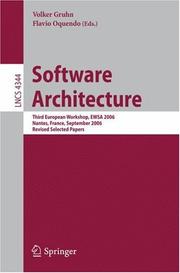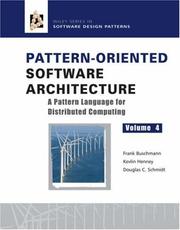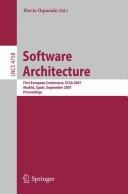| Listing 1 - 10 of 13 | << page >> |
Sort by
|
Book
ISBN: 2100499106 9782100499106 Year: 2006 Publisher: Paris : Dunod,
Abstract | Keywords | Export | Availability | Bookmark
 Loading...
Loading...Choose an application
- Reference Manager
- EndNote
- RefWorks (Direct export to RefWorks)
Software architecture --- Computer software --- Architecture logicielle --- Logiciels --- Development --- Développement
Book
ISBN: 9781934356616 Year: 2010 Publisher: Raleigh, North Carolina : Pragmatic Bookshelf,
Abstract | Keywords | Export | Availability | Bookmark
 Loading...
Loading...Choose an application
- Reference Manager
- EndNote
- RefWorks (Direct export to RefWorks)
A guide to the version control system covers such topics as working with a team, viewing the log, file locking, and setting up a server
Open source software. --- Software architecture --- Logiciels libres. --- Architecture logicielle
Book
ISBN: 9780134494166 Year: 2018 Publisher: London, England : Prentice Hall,
Abstract | Keywords | Export | Availability | Bookmark
 Loading...
Loading...Choose an application
- Reference Manager
- EndNote
- RefWorks (Direct export to RefWorks)
Building upon the success of best-sellers The Clean Coder and Clean Code, legendary software craftsman Robert C. "Uncle Bob" Martin shows how to bring greater professionalism and discipline to application architecture and design. As with his other books, Martin's Clean Architecture doesn't merely present multiple choices and options, and say "use your best judgment": it tells you what choices to make, and why those choices are critical to your success. Martin offers direct, no-nonsense answers to key architecture and design questions like: What are the best high level structures for different kinds of applications, including web, database, thick-client, console, and embedded apps? What are the core principles of software architecture? What is the role of the architect, and what is he/she really trying to achieve? What are the core principles of software design? How do designs and architectures go wrong, and what can you do about it? What are the disciplines and practices of professional architects and designers? Clean Architecture is essential reading for every software architect, systems analyst, system designer, and software manager -- and for any programmer who aspires to these roles or is impacted by their work.
Software architecture --- Computer software --- Computer programming --- Architecture logicielle --- Logiciels --- Programmation (Informatique) --- Development --- Développement --- Informatica --- Software
Book

ISBN: 9780262034760 026203476X Year: 2016 Publisher: Cambridge, Massachusetts : MIT Press,
Abstract | Keywords | Export | Availability | Bookmark
 Loading...
Loading...Choose an application
- Reference Manager
- EndNote
- RefWorks (Direct export to RefWorks)
Too often, software designers lack an understanding of the effect of design decisions on such quality attributes as performance and reliability. This necessitates costly trial-and-error testing cycles, delaying or complicating rollout. This book presents a new, quantitative architecture simulation approach to software design, which allows software engineers to model quality of service in early design stages. It presents the first simulator for software architectures, Palladio, and shows students and professionals how to model reusable, parametrized components and configured, deployed systems in order to analyze service attributes.The text details the key concepts of Palladio's domain-specific modeling language for software architecture quality and presents the corresponding development stage. It describes how quality information can be used to calibrate architecture models from which detailed simulation models are automatically derived for quality predictions. Readers will learn how to approach systematically questions about scalability, hardware resources, and efficiency. The text features a running example to illustrate tasks and methods as well as three case studies from industry. Each chapter ends with exercises, suggestions for further reading, and "takeaways" that summarize the key points of the chapter. The simulator can be downloaded from a companion website, which offers additional material. The book can be used in graduate courses on software architecture, quality engineering, or performance engineering. It will also be an essential resource for software architects and software engineers and for practitioners who want to apply Palladio in industrial settings.
Software architecture. --- Computer software --- Logiciels --- Architecture logicielle --- Computer simulation. --- Simulation par ordinateur --- Palladio (Computer program) --- Logiciels. --- Simulation par ordinateur.

ISBN: 9783540692713 3540692711 354069272X Year: 2006 Publisher: Berlin ; New York : Springer,
Abstract | Keywords | Export | Availability | Bookmark
 Loading...
Loading...Choose an application
- Reference Manager
- EndNote
- RefWorks (Direct export to RefWorks)
Following the successful workshops held in St. Andrews, Scotland, UK in 2004 (EWSA 2004, Springer LNCS 3527) and in Pisa, Italy in 2005 (EWSA 2005, Springer LNCS 3047), the 3rd European Workshop on Software Architecture (EWSA 2006) held in Nantes, France during September 4–5, 2006 provided an internationalforumforresearchersandpractitionersfromacademiaandindustry to present innovative research and discuss a wide range of topics in the area of software architecture. Software architecture has emerged as an important subdiscipline of software engineering encompassing a broad set of languages, styles, models, tools, and processes. The role of software architecture in the engineering of softwa- intensive systems has become more and more important and widespread. Ch- lenging applications include support for dynamic, adaptive, autonomic and mobile systems. The workshopfocused onformalisms,technologies,and processesfor descr- ing, verifying, validating, re?ning, building, and evolving software systems, in particular based on component and service-oriented architectures. Topics c- eredincluded architecturemodeling,architecturalaspects,architectureanalysis, transformation and synthesis, quality attributes, model-driven engineering, and architecture-based support for assembling components and developing com- nent and service-oriented systems. EWSA 2006, distinguished between two types of papers: research papers, which describe authors novel research work, and position papers, which present concise arguments about a topic of software architecture research or practice.
Software architecture --- Computer architecture --- Computer software --- Architecture logicielle --- Ordinateurs --- Logiciels d'ordinateurs --- Congresses. --- Congrès --- Architecture --- Computer Science --- Engineering & Applied Sciences --- Information Technology --- Software Engineering --- Architecture, Software --- Computer software architecture --- Design --- Computer science. --- Software engineering. --- Computer Science. --- Software Engineering/Programming and Operating Systems. --- Software Engineering. --- Computer software engineering --- Engineering --- Informatics --- Science
Book
ISBN: 9780123851260 0123851262 9780123851277 0123851270 9786613069757 128306975X 6613069752 Year: 2011 Publisher: Amsterdam Boston Morgan Kaufmann
Abstract | Keywords | Export | Availability | Bookmark
 Loading...
Loading...Choose an application
- Reference Manager
- EndNote
- RefWorks (Direct export to RefWorks)
Data is an expensive and expansive asset. Information capture has forced storage capacity from megabytes to terabytes, exabytes and, pretty soon, zetabytes of data. So the need for accessible storage space for this data is great. To make this huge amount of data usable and relevant, it needs to be organized effectively. Database Base Management Systems, such as Oracle, IBM's DB2, and Microsoft SqlServer are used often, but these are being enhanced continuously and auxiliary tools are being developed every week; there needs to be a fundamental starting point for it all. That stating point is
Data structures (Computer science) --- Software architecture. --- Structures de données (Informatique) --- Architecture logicielle --- Architecture, Software --- Computer software --- Computer software architecture --- Information structures (Computer science) --- Structures, Data (Computer science) --- Structures, Information (Computer science) --- Electronic data processing --- File organization (Computer science) --- Abstract data types (Computer science) --- Architecture --- Design
Book
ISBN: 1283258536 9786613258533 0262295210 9780262295215 9781283258531 6613258539 9780262015424 0262015420 9780262518512 0262518511 Year: 2011 Publisher: Cambridge, Mass. MIT Press
Abstract | Keywords | Export | Availability | Bookmark
 Loading...
Loading...Choose an application
- Reference Manager
- EndNote
- RefWorks (Direct export to RefWorks)
Wendy Hui Kyong Chun argues that cycles of obsolescence & renewal result in part from the ways in which new media encapsulates a logic of programmability. In seeking to embody a future based on past data, new media becomes a metaphor for metaphor itself.
Computer software -- Development -- Social aspects. --- Computer software -- Human factors. --- Software architecture -- Social aspects. --- Computer software --- Software architecture --- Engineering & Applied Sciences --- Computer Science --- Social aspects --- Development --- Human factors --- Social aspects. --- Human factors. --- Computer software ergonomics --- Human factors in computer software --- Human factors in software --- Software ergonomics --- Architecture, Software --- Computer software architecture --- Software, Computer --- Architecture --- Design --- Human engineering --- Computer systems --- DIGITAL HUMANITIES & NEW MEDIA/Software Studies --- SOCIAL SCIENCES/Media Studies --- SCIENCE, TECHNOLOGY & SOCIETY/General --- Logiciels --- Architecture logicielle --- Développement --- Aspect social --- Facteurs humains

ISBN: 9780470059029 Year: 2007 Publisher: West Sussex : Wiley ,
Abstract | Keywords | Export | Availability | Bookmark
 Loading...
Loading...Choose an application
- Reference Manager
- EndNote
- RefWorks (Direct export to RefWorks)
Software architecture --- Software patterns --- Computer software --- Architecture logicielle --- Design patterns. --- Logiciels --- Development --- Développement. --- -681.3* / / / / / / / / / / / / / / / / / / / / / / / / / / / / --- 681.3*D2 --- 681.3*D210 --- 681.3*D210 Design: methodologies; representation (Software engineering) --- Design: methodologies; representation (Software engineering) --- 681.3*D2 Software engineering: protection mechanisms; standards--See also {681.3*K63}; {681.3*K51} --- Software engineering: protection mechanisms; standards--See also {681.3*K63}; {681.3*K51} --- Software, Computer --- Computer systems --- Computerwetenschap --- -Development --- Développement.

ISBN: 0131829572 9780131829572 Year: 1996 Publisher: Upper Saddle River, N.J. Prentice Hall
Abstract | Keywords | Export | Availability | Bookmark
 Loading...
Loading...Choose an application
- Reference Manager
- EndNote
- RefWorks (Direct export to RefWorks)
Programming --- software engineering --- Software architecture --- Architecture logicielle --- Software architecture. --- Computer architecture --- Computer software --- 681.3*D2 --- 681.3*D210 --- 681.3*K63 --- Software, Computer --- Computer systems --- Architecture, Computer --- Software engineering: protection mechanisms; standards--See also {681.3*K63}; {681.3*K51} --- Design: methodologies; representation (Software engineering) --- Software management: software development; software selection; software maintenance --- 681.3*K63 Software management: software development; software selection; software maintenance --- 681.3*D210 Design: methodologies; representation (Software engineering) --- 681.3*D2 Software engineering: protection mechanisms; standards--See also {681.3*K63}; {681.3*K51} --- Architecture, Software --- Computer software architecture --- Architecture --- Design

ISSN: 03029743 ISBN: 9783540751311 3540751319 3540751327 Year: 2007 Volume: 4758 Publisher: Berlin, Heidelberg : Springer Berlin Heidelberg : Imprint: Springer,
Abstract | Keywords | Export | Availability | Bookmark
 Loading...
Loading...Choose an application
- Reference Manager
- EndNote
- RefWorks (Direct export to RefWorks)
Software architecture has emerged as an important subdiscipline of software engineering encompassing a broad set of languages, styles, models, tools, and processes. The role of software architecture in the engineering of software-intensive applications has become more and more important and widespread. Indeed, component-based and service-oriented architectures have become key to the design, development, and evolution of most software systems. The European Conference on Software Architecture (ECSA) is the premier European conference dedicated to the field of software architecture, covering all architectural features of software and service engineering. It is the follow-up of a successful series of European workshops on software architecture held in the United Kingdom in 2004 (Springer LNCS 3047), Italy in 2005 (Springer LNCS 3527), and France in 2006 (Springer LNCS 4344). Due to its success, it has evolved into a fu- fledged series of European conferences whose first edition was ECSA 2007, held in Madrid, Spain September 24–26, 2007. ECSA 2007 provided an international forum for researchers and practitioners from academia and industry to present innovative research and to discuss a wide range of topics in the area of software architecture. It focused on formalisms, technologies, and processes for describing, verifying, validating, transforming, building, and evolving software systems, in particular founded on component-based and service-oriented architectures. Covered topics included architecture modeling, architectural aspects, architecture analysis, transformation and synthesis, quality attributes, model-driven engineering, and architecture-based support for developing, adapting, reconfiguring, and evolving component-based and service-oriented systems.
Software architecture --- Architecture logicielle --- Congresses. --- Congrès --- Computer architecture --- Computer software --- Computer Science --- Engineering & Applied Sciences --- Architecture, Software --- Computer software architecture --- Architecture --- Design --- Computer science. --- Software engineering. --- Programming languages (Electronic computers). --- Computers. --- Computer Science. --- Software Engineering/Programming and Operating Systems. --- Software Engineering. --- Models and Principles. --- Programming Languages, Compilers, Interpreters. --- Automatic computers --- Automatic data processors --- Computer hardware --- Computing machines (Computers) --- Electronic brains --- Electronic calculating-machines --- Electronic computers --- Hardware, Computer --- Computer systems --- Cybernetics --- Machine theory --- Calculators --- Cyberspace --- Computer languages --- Computer program languages --- Computer programming languages --- Machine language --- Electronic data processing --- Languages, Artificial --- Computer software engineering --- Engineering --- Informatics --- Science --- Software architecture - Congresses --- Computer architecture - Congresses --- Computer software - Congresses
| Listing 1 - 10 of 13 | << page >> |
Sort by
|

 Search
Search Feedback
Feedback About UniCat
About UniCat  Help
Help News
News